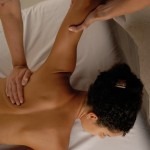Does Deep Tissue Massage Hurt?
Deep Tissue Massage: is it supposed to hurt?
A Deep Tissue massage has a reputation-that it hurts!
It is an often misunderstood term in the massage world. It is often assumed that “deep tissue massage” means neuromuscular massage or myotherapy, utilizing deep pressure and friction, often in a rough or less comfortable and sometimes even painful manner. A lot of massage therapists themselves are even taught that Deep Tissue Massage is supposed to be painful. I know I was taught that. Unfortunately this preconception from therapists and clients alike can scare people away from trying it out. Massaging deep tissues is often extremely useful in cases of chronic muscle tension, muscle spasms, poor posture, repetitive strain, pain conditions, and recovery from injury. What you may not realize, is that there are a multitude of body work techniques that address deep tissues in various manners, and with a wide variety of intensity. The following are some of the most common techniques:
Frictioning and Cross Fiber Frictioning

Some more specific therapeutic techniques like frictioning and cross fiber frictioning can often be more uncomfortable and even painful, especially when working with compromised or damaged tissue. These are techniques frequently used in “deep tissue massage” but are in no way the only definition of it. The basic idea is to find an area of injured tissue, often near where it attaches to the bone or in the case of a spasming muscle (trigger point) perhaps the middle of the muscle belly, and move the muscle fibers against the grain in an effort to spread the fibers out.
Trigger Point Therapy
Trigger point therapy, as mentioned above, can be used in conjunction with other techniques but can also be practiced as a stand-alone technique. A trigger point (TrP) refers to a muscle that can trigger sensations in areas beyond itself. For instance, a TrP in one of the rotator cuff muscles, the subscapularis, can create a feeling of heaviness down the arm at the wrist. It can feel like you’re wearing a watch, even if you aren’t, or can even be painful. Using palpation to find bundled tissues or following the referral symptoms a client has complained about, a therapist locates an active TrP. They will then try to alleviate or deactivate the TrP. Sometimes a little pressure and patience is all that is needed. When it isn’t enough, a therapist can utilize other techniques such as friction, ironing, myofascial techniques or even stretching. Since TrP’s can send sensations to other areas of the body, pain sensations can be deceiving. A person may complain to their doctor or massage therapist of lower back pain and ask to get some sort of attention to that area. More often than not, lower back pain can be attributed to structural issues or TrP’s in other areas such as the deep abdominals. A little work on these muscles will often alleviate all the symptoms.
Sports Massage
Sports massage is also a misinterpreted term and often has to do more with timing than the technique itself. Generally speaking, sports massage will often utilize stretching and a broad ironing of the fist or forearms to lengthen and displace tissues. Sports massage may utilize
sports massage relieves inflammation A Sports Massage builds muscle and relieves inflammationtrigger point therapy or other techniques as well, it is often considered more about timing and intention than a specific technique.
Myofascial Massage
Some techniques of myofascial massage can be a little more aggressive. Deep ironing with a fist or forearm, as often done in sports massage, can have a burning or skin stretching sensation. Other techniques such as rolphing which is often a little more aggressive with the myofascial work and geared towards the deeper tissues can have some intensity to it and may feel even a little painful.
Does Deep Tissue Massage Have to be Painful?
Discomfort and pain has been mentioned several times while talking about the various forms of deep tissue massage so far. Depending on the clients’ condition, that may be unavoidable using even the lightest of Swedish Massage. Pain can be a good indicator that something is wrong and needs to be addressed. It is important, when considering massage and the various techniques, that you find a style that is right for you. You might have a high pain tolerance and expectation of pain may lead to a practitioner who just likes to “dig right in” so to say. If pain “isn’t your thing”, perhaps a person utilizing a light myofascial technique may be your best bet. If you’ve had a bad experience or two, don’t get discouraged. There are lots of options out there.
And communicate, even the best therapists can’t read minds and are more often than not willing to adjust their approach to find the best method of helping you. We may even practice multiple techniques or approaches within a technique to draw from. Whatever your level of tolerance, there’s a therapist out there for you.
Give me a call. I’ll show you how you can have all the benefits without suffering!
Cade Holmseth, BFA, LMT, CMT, is Nationally Certified and an award-winning, St. Paul Licensed Massage Therapist.
For more information see our About Us page